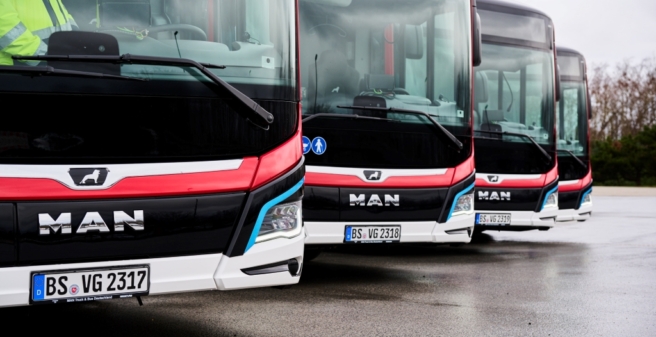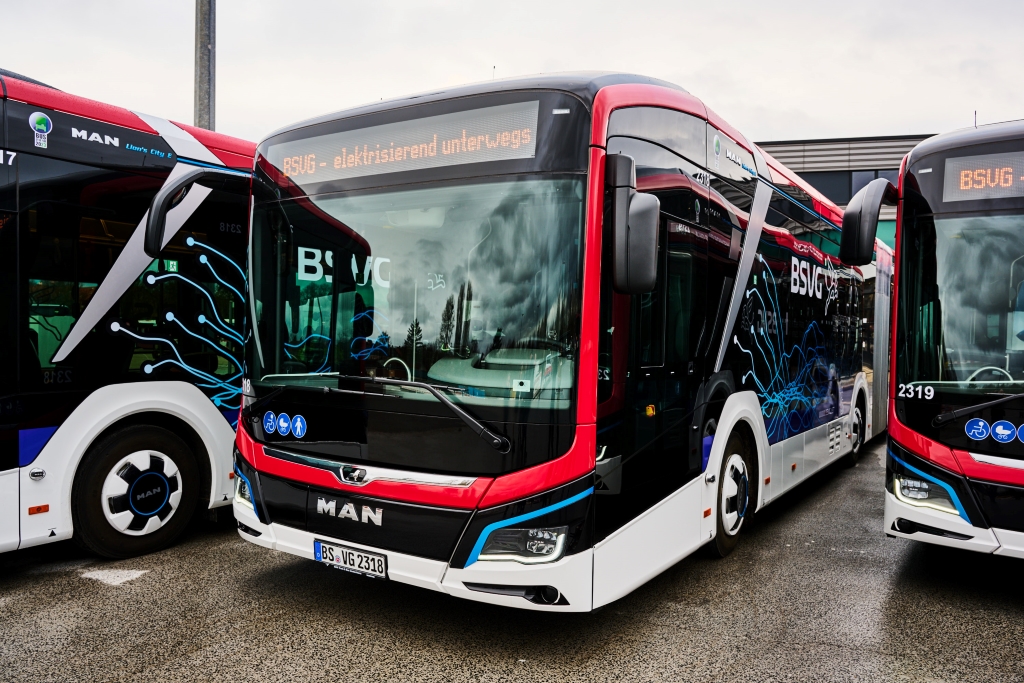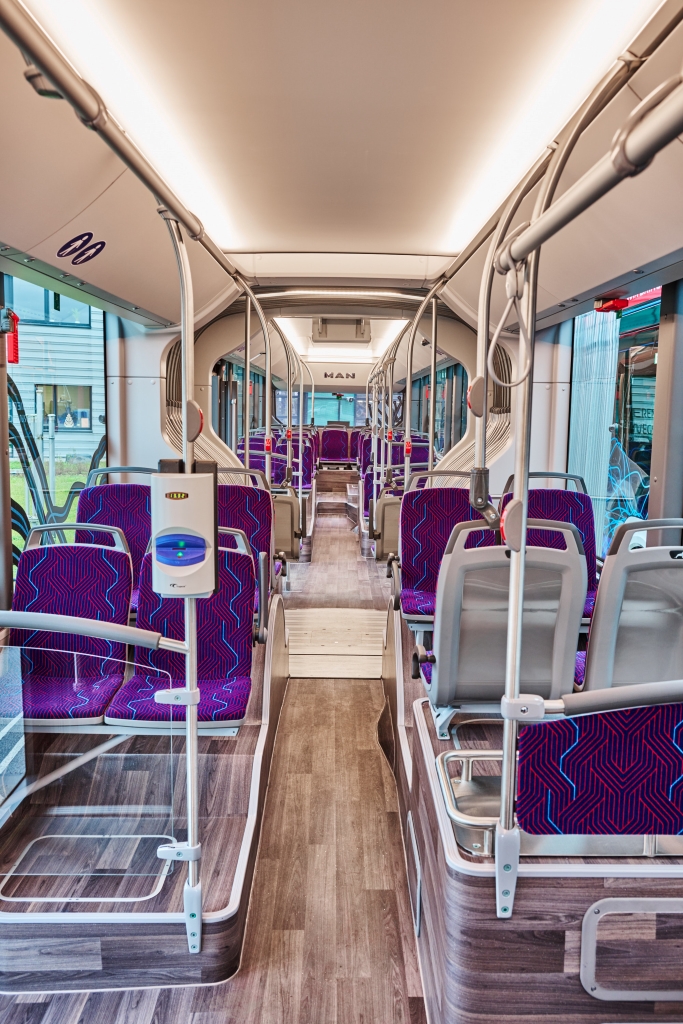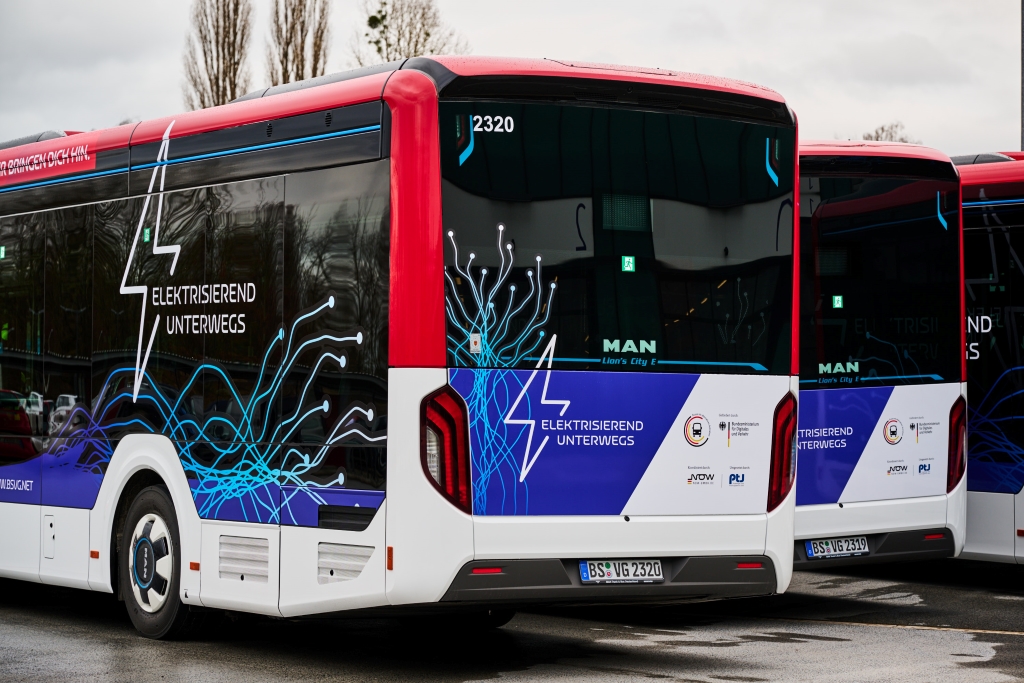
On 4 January 2024, Braunschweiger Verkehrs GmbH (BSVG) presented four new electric buses, namely the MAN Lion City 18 E buses 2317 and 2318 and the MAN Lion’s City 12 E buses 2319 and 2320 (i.e. they still have last year’s operating numbers). They are something completely new for Brauinschweig, and not just because they have only just been put into service.
Braunschweig’s first electric buses with inductive charging
The age of battery-electric buses began at BSVG back in 2014. At that time, five such buses were put into service: Solaris Urbino 12 electric bus 1401 and Solaris Urbino 18 electric buses 1412 to 1415. They were designed for recharging on the line, with Braunschweig relying on inductive recharging according to the Bombardier Primove system: the bus drives over a charging plate embedded in the carriageway at stops on its route, and the bus draws induced “fresh electricity” from below while at the stop.
A second-hand bus ex Mannheim
Initially, two other cities also recharged their electric buses inductively: Berlin and Mannheim. However, while Braunschweig’s BSVG always emphasised that it was satisfied with inductive recharging, Berlin and Mannheim soon discontinued this form of operation. (Both companies have since switched to reloading via pantograph.) And so Braunschweig was able to take over one of Mannheim’s inductive reloaders, a Swiss Hess from the 2015 vintage (ex Mannheim 6002), as a second-hand bus 1501. Since then, it has been cheerfully doing its rounds on Braunschweig’s line 436.
New recharging technology now also in Braunschweig
With the new electric buses, BSVG is now also saying goodbye to inductive recharging. Although the previous vehicles with this operating mode will remain in use, the four new vehicles are designed exclusively for overnight recharging at the depot using cables and CCS combo plugs. This shows one thing very clearly: the batteries installed in the buses have become much more powerful. You no longer have to recharge “every so often”.
The four new MAN buses are the first of a total of 50 electric buses that BSVG has ordered for delivery by the end of 2025. MAN will supply 32 of these vehicles, with the remaining 18 coming from Mercedes. The 32 MANs will all be depot chargers, while the 18 Mercedes (eCitaro) will also be able to be recharged on the route via pantograph. BSVG boss Jörg Reincke: “The mix of depot and occasional chargers allows us to utilise the advantages of both systems in our route network. And we are also gaining important experience for the further electrification of our bus fleet.”
2.69 million has been invested in the four new MAN Lion’s City E buses. Grants were provided by the Federal Ministry of Transport and the Lower Saxony LNVG (Landes-Nahverkehrs-Gesellschaft). The Federal Ministry of Transport is also subsidising the construction of the necessary charging infrastructure. BSVG boss Reincke: “We are extremely grateful for the funding from the federal government and the state of Lower Saxony.”
From Monday, 8 January, the new MAN electric buses will be used on routes 411, 418, the two opposite-running ring routes 419 and 429 and the L routes 422 and 426.

The new electric buses in detail
Let’s take a closer look at the four new Braunschweig buses. The two solo buses have a battery capacity of 480 kWh and a minimum range of 230 km, while the two articulated buses can store 640 kWh and have a minimum range of 180 km. This shows that an articulated bus has a “heavy load” to carry due to its greater weight. The new buses are charged via CCS combo plugs with direct current, the charging capacity is 150 kW.
The two solo buses are designed for 73 passengers, the two articulated buses for 97. They all have a special use area at door two, for example for wheelchairs and pushchairs; the two articulated buses also have such a special use area at door 3, the door in the rear part of the bus.
The buses are equipped with cornering assistants and “blind spot detection”. This ensures that no one is “run under” because the driver could not see them.
At low speeds, the vehicles will draw attention to themselves with artificially generated “driving noises”, because otherwise they would be too quiet and passers-by would not be able to hear them. Somehow this sounds like a contradiction in terms: isn’t the clear advantage of the electric bus, that it is so quiet, being “given away” again?
The new buses are painted in BSVG’s long-established corporate identity of wine red and white, with the electric buses now also featuring elements in turquoise. They also bear the lettering “Electrifying on the move”. The interior features new seat covers in wine red, white, and light blue.


All photos: © BSVG
08.01.2024
